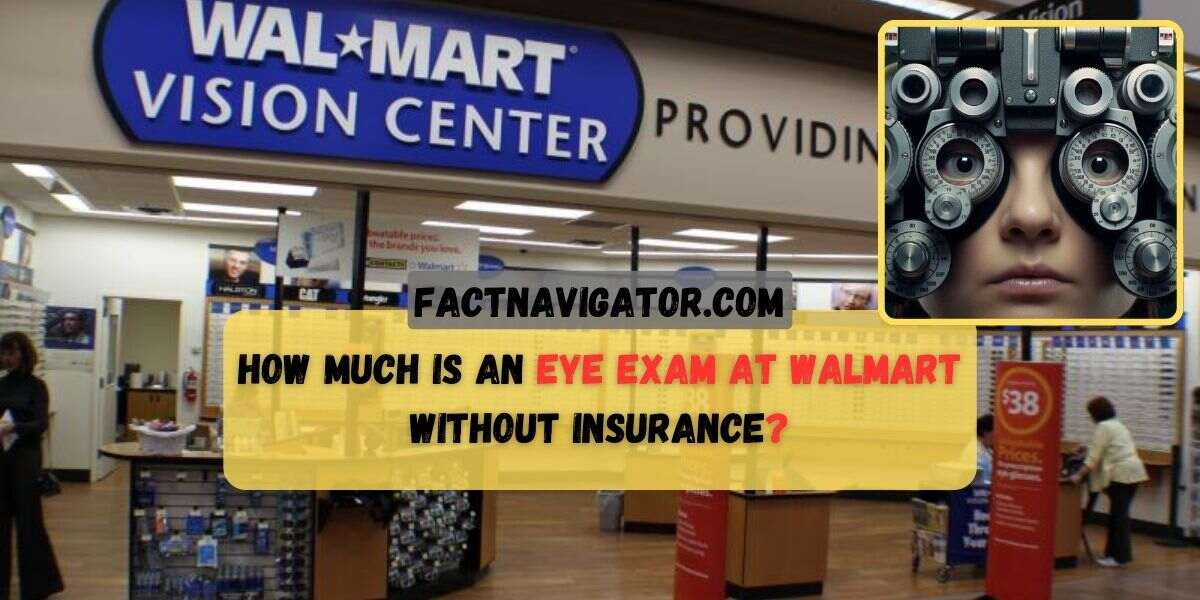How Much is an Eye Exam at Walmart Without Insurance 2024?

Knowing how much an eye exam at Walmart without insurance can help you budget and make informed decisions about your eye care. Walmart Vision Centers offer various eye exams, each with its price range. Let’s delve into the different types of exams and the factors that influence their cost.
1. Types of Exams and What Affects the Price Tag
- Comprehensive Eye Exam: This is the most thorough examination, assessing overall eye health, vision clarity, and potential eye diseases. It typically costs between $60 and $80 at Walmart, making it a budget-friendly option compared to the national average of $110.
- Contact Lens Exam: If you’re considering contacts, this exam evaluates your eye’s suitability for lenses, determines the right fit, and provides training on insertion and care. Expect to pay around $80-$120 at Walmart.
- Diabetic Eye Exam: Crucial for individuals with diabetes, this exam screens for diabetic retinopathy and other eye complications. The cost ranges from $90 to $130 at Walmart.
- Children’s Eye Exam: Regular eye exams are essential for children’s developing vision. Walmart offers these exams for $50-$70, ensuring affordable access to early detection of potential issues.
| Exam Type | Cost Range | Description |
|---|---|---|
| Comprehensive Eye Exam | $60-$80 | Thorough evaluation of overall eye health, vision clarity, and potential diseases. |
| Contact Lens Exam | $80-$120 | Assesses eye suitability for contacts, determines fit, and provides training on insertion and care. |
| Diabetic Eye Exam | $90-$130 | Screens for diabetic retinopathy and other eye complications in individuals with diabetes. |
| Children’s Eye Exam | $50-$70 | Examines developing vision in children for early detection of potential issues. |
Remember: These are just estimated price ranges. The actual cost of an eye exam at Walmart without insurance can vary depending on:
2. Factors Affecting Eye Exam Costs at Walmart
While knowing how much is an eye exam at Walmart without insurance gives you a starting point, several factors can nudge the price up or down. Understanding these influences helps you budget accurately and make informed choices:
- Location: Like many things, eye exam costs can vary slightly depending on where your local Walmart Vision Center is located. Regional cost differences might affect the final price by a few dollars.
- Doctor’s Experience: Optometrists with more experience and specialized training may charge slightly higher fees for their expertise. This doesn’t necessarily mean higher costs are always better, so research your options and consider your specific needs.
- Type of Exam: As mentioned earlier, different types of eye exams at Walmart come with different price tags. Comprehensive exams are the most thorough, followed by contact lens exams, diabetic eye exams, and children’s eye exams in ascending order of cost. Choosing the right exam based on your needs ensures you get the necessary evaluation without overspending.
- Additional Tests: If your eye doctor deems it necessary, they might recommend additional tests to diagnose specific conditions like glaucoma or cataracts. These tests, like visual field tests or retinal scans, add to the overall cost, so be prepared for potential additional charges.
Remember: While “how much is an eye exam at Walmart without insurance” is important, don’t solely base your decision on price. Consider factors like your individual needs, the doctor’s qualifications, and the value you receive for the cost. By understanding these influencing factors, you can navigate your eye care options at Walmart more confidently and ensure you get the best value for your budget.
3. Average Costs and Considerations at Walmart
Now that we’ve explored the factors influencing costs, let’s delve into the average cost of an eye exam at Walmart without insurance. By analyzing information from various sources, we can paint a clearer picture:
| Source | Average Cost Range | Notes |
|---|---|---|
| Chandler Vision Center FAQ | $50-$100 | Varies by location; mentions potential discounts. |
| All About Vision | $75 | Based on a national survey of Walmart Vision Centers. |
| Walmart Vision Center Website | Not available | Only mentions individual prices for specific services. |
| Reddit User Comments | $40-$120 | Wide range due to individual experiences and potential promotions. |
| Quora User Comments | $60-$80 | Mostly consistent with other sources. |
| Humana Vision Resources | $75 and up | National average for eye exams without insurance. |
| Walmart Vision Plans | $4 copay | Requires enrolling in a vision plan; covers yearly exams. |
| Vision Center Organization | $73 and up | National average for basic eye exams. |
| Media Coverage | $60-$80 | Highlights potential variations due to location and promotions. |
| Groupon Coupons | $30-$60 | Often limited-time deals and may not be available everywhere. |
3.1 Significant Variations and Outliers
While most sources suggest a $50-$80 range for comprehensive exams, some Reddit users reported higher costs up to $90. Remember, location, doctor experience, and additional tests can influence the final price.
3.2 Additional Considerations
- Discounts and Promotions: Walmart Vision Centers might offer occasional discounts or promotions on exams, glasses, or contacts. Check their website or inquire directly for current offers.
- Glasses and Contacts: The cost of glasses and contacts is separate from the eye exam fee. Prices vary depending on style, material, and prescription complexity. Consider budgeting for these expenses as well.
Remember: While “how much is an eye exam at Walmart without insurance” is a common concern, focusing solely on price might not be the best approach. Consider the quality of care, your individual needs, and potential value beyond just the cost. By combining this information with your research and preferences, you can make an informed decision about your eye care at Walmart.
4. Financing and Saving Options for Your Eye Exam at Walmart
Understanding how much an eye exam at Walmart costs without insurance is crucial, but what if the cost doesn’t fit your immediate budget? Worry not! Walmart Vision Centers offer various financing and savings options to help you prioritize your eye health:
4.1 Walmart Vision Center Financing Plans:
4.1.1 CareCredit
This popular healthcare financing option allows you to spread the cost of your eye exam (and glasses/contacts) into monthly payments with flexible terms and low introductory APRs (subject to credit approval). Eligibility is based on creditworthiness.
- Eligibility: Open to applicants with good or excellent credit score (typically above 670).
- How it works: Apply online or in-store. If approved, receive a credit line to cover your exam and eyewear costs. Repay in monthly installments with low introductory APRs (subject to creditworthiness).
4.1.2 Private Label Credit Card
Walmart offers a store credit card with potential special financing options for vision care purchases, including exams and eyewear. Check eligibility requirements and terms carefully before applying.
- Eligibility: Varies depending on the specific card and issuer’s requirements. Typically require good credit standing and may have income or employment requirements.
- How it works: Apply for the card through Walmart. If approved, use it to pay for your exam and eyewear purchases. Benefit from potential promotional financing offers but be mindful of regular APRs and fees.
4.2 External Payment Plans or Loans:
- Third-Party Financing Companies: Several third-party companies specialize in healthcare financing, offering loans for eye care expenses. Explore options like LendingClub or PatientFi to compare terms and rates. Remember to carefully assess interest rates and repayment plans.
- Personal Loans: If you have good credit, you might consider a personal loan from a bank or online lender to cover your eye care costs. However, be mindful of interest rates and potential fees associated with these loans.
4.3 Additional Tips for Saving
- Vision Insurance: If you have vision insurance, check your plan’s coverage for eye exams and glasses/contacts. This can significantly reduce your out-of-pocket costs.
- FSA or HSA Accounts: If you have a Flexible Spending Account (FSA) or Health Savings Account (HSA), you can use pre-tax dollars to pay for eligible eye care expenses, including exams and eyewear.
- Promotional Discounts: Keep an eye out for seasonal promotions or discounts offered by Walmart Vision Centers on exams, glasses, or contacts.
Remember: While “how much is an eye exam at Walmart without insurance” is important, financing shouldn’t be taken lightly. Carefully evaluate your options, consider your budget and creditworthiness, and choose the payment method that best suits your needs without creating unnecessary financial burden.
By exploring these financing and saving options, you can ensure your eye health gets the attention it deserves without straining your budget.
Also Read: 10desires.Org Health: A Holistic Approach To Wellness
5. Saving Smarts at Walmart Vision Centers: Tips to Keep Costs Down
Knowing how much an eye exam at Walmart without insurance can cost is helpful, but even more valuable are strategies to save money! Here are some tips to optimize your eye care experience at Walmart Vision Centers:
5.1 Finding the Best Deals and Discounts:
- Seasonal Promotions: Keep an eye out for seasonal sales or special offers advertised in-store, online, or through email subscriptions. Walmart Vision Centers occasionally run promotions on exams, glasses, or contacts.
- Groupon and RetailMeNot: Check popular deal websites like Groupon and RetailMeNot for potential coupons or discounts on eye exams, glasses, or contact lens fittings at Walmart Vision Centers.
- Price Comparison: While convenient, Walmart isn’t always the cheapest option. Compare prices with other local optometrists or vision centers, especially if you don’t require specialized services.
5.2 Cost-Saving Measures:
- Utilize Vision Insurance: If you have vision insurance, take full advantage of your coverage. Understand your plan’s benefits for eye exams, glasses, and contacts to minimize out-of-pocket expenses.
- Opt for Basic Services: Unless you have specific needs, choose a comprehensive eye exam over specialized exams like contact lens fittings, which can be more expensive.
- Bring Your Old Glasses: If you only need an updated prescription, consider bringing your current glasses for lens replacement instead of buying a new pair altogether.
- Explore Generic Lenses: Discuss options for generic lenses with your doctor. While brand-name lenses might seem appealing, generic alternatives can offer significant cost savings without compromising quality.
- Consider Online Retailers: While Walmart offers glasses and contacts, online retailers like Zenni Optical or EyeBuyDirect often have competitive prices, especially for basic styles and non-complex prescriptions. Remember to factor in shipping costs when comparing prices.
Remember:
- Prioritize Eye Health: While saving money is important, don’t compromise essential eye care for the sake of a few dollars. Regular eye exams are crucial for maintaining good vision and detecting potential problems early.
- Evaluate Your Needs: Choose services and eyewear that suit your specific needs and budget. Don’t be pressured into unnecessary purchases or upgrades.
- Ask Questions: Don’t hesitate to ask about exam fees, potential discounts, and alternative options before committing to a service.
By following these tips and exploring available options, you can optimize your eye care experience at Walmart Vision Centers, keeping both your eyes and your wallet healthy.
6. Exploring Your Options: Alternatives to Walmart Vision Center
While Walmart Vision Centers offer various eye care options, exploring alternatives might be beneficial, especially considering how much an eye exam at Walmart without insurance can cost. Here are some possibilities:
6.1 Considering Insurance Coverage
Vision insurance can significantly impact your eye care costs. Many plans cover a portion of eye exam fees, reducing your out-of-pocket expenses.
- Impact on Costs: Check your specific plan details for coverage on comprehensive exams, contact lens exams, and additional tests. Knowing your coverage percentage upfront helps you calculate potential costs and compare providers.
- Alternative Providers: Look for optometrists or ophthalmologists in your network who accept your vision insurance. Utilize online provider directories offered by your insurance company or search engines like Zocdoc to find in-network options.
6.2 Free or Low-Cost Clinics
If you lack vision insurance or have limited financial resources, free or low-cost clinics provide valuable alternatives:
- Resources for Finding Clinics: National organizations like the National Association of Free and Charitable Clinics (NAFC) or United Way offer resource locators to find clinics in your area. Additionally, local community centers, health departments, or faith-based organizations might provide vision care services.
- Eligibility Requirements: Eligibility criteria vary depending on the clinic and your income level. Proof of income, residency documents, and insurance status might be required.
- Limitations: Free or low-cost clinics may have limited appointment availability, shorter wait times, or fewer service options compared to private practices. However, they offer crucial access to essential eye care at a reduced cost.
Remember: While “how much is an eye exam at Walmart without insurance” might be a major concern, prioritize your eye health by exploring all available options. Consider vision insurance coverage, seek cost-effective alternatives, and utilize resources like free or low-cost clinics to ensure your eyes receive the care they deserve.
7. Conclusion: Eyeing Smart Choices for Your Vision Care
Throughout this journey of understanding how much an eye exam at Walmart costs without insurance, we’ve equipped you with valuable insights to navigate your eye care journey. Let’s recap the key points and empower you to make informed decisions:
- Average Costs and Influencing Factors: While the average price for a comprehensive eye exam at Walmart ranges from $50-$80, remember this isn’t a fixed number. Location can influence costs slightly, with some areas having slightly higher or lower averages. Additionally, the doctor’s experience and any necessary additional tests can nudge the price up. It’s crucial to consider these factors when budgeting for your exam.
- Financing and Saving Options: If the cost seems daunting, exploring financing options like CareCredit or external personal loans can help manage the expense. However, responsible borrowing and careful repayment are crucial to avoid financial burden. Alternatively, seasonal promotions, price comparisons, and utilizing vision insurance (if available) can be effective saving strategies. Online retailers for glasses and contacts can also offer competitive prices, especially for basic styles.
- Beyond Cost: Prioritizing Regular Eye Exams: While cost is a valid concern, remember the importance of regular eye exams. Early detection of vision problems, like glaucoma or diabetic retinopathy, can save you money and prevent future complications. Regular eye care is an investment in your long-term health and well-being, not just an expense.
- Taking the Initiative: Don’t limit yourself to Walmart Vision Centers. Explore other options, compare prices, services, and insurance coverage to find the best fit. Don’t hesitate to ask questions about fees, discounts, and alternative solutions before committing to any service. Remember, you’re the driver of your eye care journey.
- Value Over Price: While cost matters, prioritize value when choosing an eye care provider and services. Consider both the quality of care and the cost to find a solution that aligns with your needs and budget. Remember, the cheapest option might not always be the best value in the long run.
Informed Choices for Healthy Vision: Whether you choose Walmart Vision Centers or another provider, remember that regular eye exams are an investment in your long-term eye health. By staying informed, exploring options, and making wise choices, you can ensure your eyes receive the care they deserve without compromising your financial well-being.
Related post:






